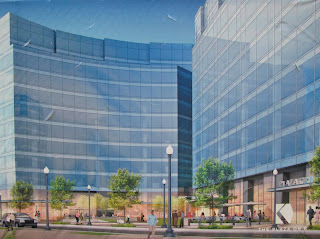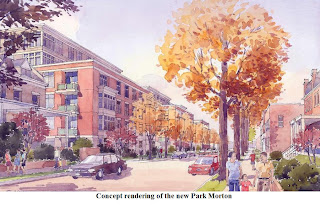 Cemetery's got some much needed relief this week as the Arlington County Board approved a land swap of two 4.3 acre parcels - one belonging to the federal government, the other to the County - that will allow the military burial ground to expand its borders after 2011. In exchange, Arlington County will receive a westerly portion of the Navy Annex that it will use as a site for the long-proposed Black Heritage Museum of Arlington.
Cemetery's got some much needed relief this week as the Arlington County Board approved a land swap of two 4.3 acre parcels - one belonging to the federal government, the other to the County - that will allow the military burial ground to expand its borders after 2011. In exchange, Arlington County will receive a westerly portion of the Navy Annex that it will use as a site for the long-proposed Black Heritage Museum of Arlington. The roots of the deal go back 3 years to when Senator John Warner and Representative James Moran - both of Virginia - engineered a clause in the 2005 Federal Defense Authorization Bill that allowed the cemetery's de facto landlord, the US Department of Defense, to commence negotiations with the County.
The roots of the deal go back 3 years to when Senator John Warner and Representative James Moran - both of Virginia - engineered a clause in the 2005 Federal Defense Authorization Bill that allowed the cemetery's de facto landlord, the US Department of Defense, to commence negotiations with the County.Apparently, both county and federal officials are seeing this unusual turn of events as a win-win situation. “The cemetery acquires new ground for much-needed expansion while the County gains a well-situated, historically significant focal point for community, its past and its legacy,” said Board Chairman J. Walter Tejada, via a press release issued Tuesday.
With the World War II generation dropping away faster than ever, officials at Arlington National Cemetery have been looking for ways to counter the calamitous consequences of overcrowding the 612-acre site. Last year, they initiated the Millennium Project – a $35 million expansion of the cemetery’s northwest edge. So far, Millennium has acquired 10 acres from the neighboring Army complex at Fort Meyer and recovered 4 acres of former maintenance space within its own borders. Millennium still aims to utilize roughly 40 more acres of “unutilized” space within Arlington National Cemetery proper.
Meanwhile, the other beneficiary of the deal, the Black Heritage Museum of Arlington (which currently bills itself as “a museum without walls” due to its lack of permanent quarters) will have to make do with temporary exhibits throughout the County for the foreseeable future. As Arlington County has yet to commit to a timeline beyond the 2011 exchange date, all details pertaining to its new proposed home at the Navy Annex are tentative at best. However, one resource at the disposal of museum management is the Columbia Pike Revitalization Organization, who recently pushed (and succeeded) in getting the nearby Arlington Mill Community Center cleared for extensive, mixed-use redevelopment.




















.JPG)
.jpg)
.jpg)






























